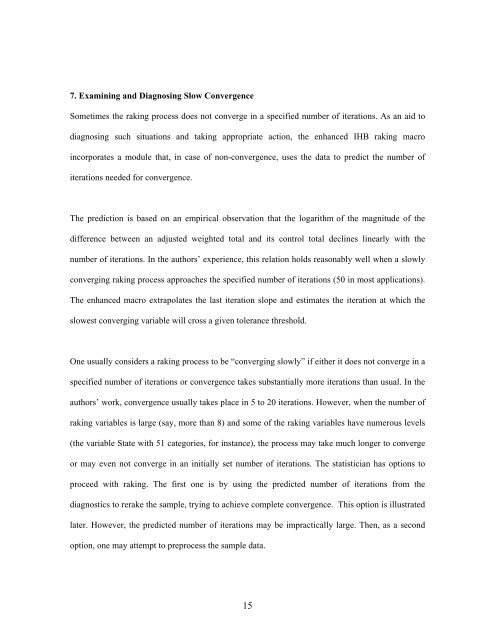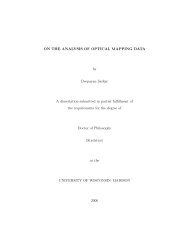Practical Considerations in Raking Survey Data
Practical Considerations in Raking Survey Data
Practical Considerations in Raking Survey Data
You also want an ePaper? Increase the reach of your titles
YUMPU automatically turns print PDFs into web optimized ePapers that Google loves.
7. Exam<strong>in</strong><strong>in</strong>g and Diagnos<strong>in</strong>g Slow Convergence<br />
Sometimes the rak<strong>in</strong>g process does not converge <strong>in</strong> a specified number of iterations. As an aid to<br />
diagnos<strong>in</strong>g such situations and tak<strong>in</strong>g appropriate action, the enhanced IHB rak<strong>in</strong>g macro<br />
<strong>in</strong>corporates a module that, <strong>in</strong> case of non-convergence, uses the data to predict the number of<br />
iterations needed for convergence.<br />
The prediction is based on an empirical observation that the logarithm of the magnitude of the<br />
difference between an adjusted weighted total and its control total decl<strong>in</strong>es l<strong>in</strong>early with the<br />
number of iterations. In the authors’ experience, this relation holds reasonably well when a slowly<br />
converg<strong>in</strong>g rak<strong>in</strong>g process approaches the specified number of iterations (50 <strong>in</strong> most applications).<br />
The enhanced macro extrapolates the last iteration slope and estimates the iteration at which the<br />
slowest converg<strong>in</strong>g variable will cross a given tolerance threshold.<br />
One usually considers a rak<strong>in</strong>g process to be “converg<strong>in</strong>g slowly” if either it does not converge <strong>in</strong> a<br />
specified number of iterations or convergence takes substantially more iterations than usual. In the<br />
authors’ work, convergence usually takes place <strong>in</strong> 5 to 20 iterations. However, when the number of<br />
rak<strong>in</strong>g variables is large (say, more than 8) and some of the rak<strong>in</strong>g variables have numerous levels<br />
(the variable State with 51 categories, for <strong>in</strong>stance), the process may take much longer to converge<br />
or may even not converge <strong>in</strong> an <strong>in</strong>itially set number of iterations. The statistician has options to<br />
proceed with rak<strong>in</strong>g. The first one is by us<strong>in</strong>g the predicted number of iterations from the<br />
diagnostics to rerake the sample, try<strong>in</strong>g to achieve complete convergence. This option is illustrated<br />
later. However, the predicted number of iterations may be impractically large. Then, as a second<br />
option, one may attempt to preprocess the sample data.<br />
15
















